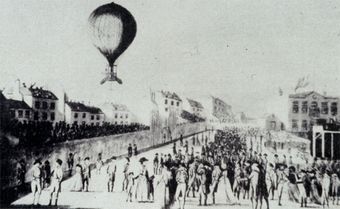Annotation:Air Balloon (1) (The)
X:1 T:Air Balloon [1], The M:C| L:1/8 R:Country Dance N:"Dances 1785" B:Samuel, Ann & Peter Thompson - Compleat Collection of 200 Favourite Country Dances, vol. 5 (1788, p. 37) Z:AK/Fiddler's Companion K:A A2 Ac E2E2|A2 Ac E4|FGAB cdef|fedc cBAG| A2 Ac E2E2|A2 Ac E4|efef fedc|1cBAG A4:|2cBAG A3:| |:A|fgaf e2A2|fgaf e4|fgaf fedc|cBAG A2 Ee| fgaf e2A2|fgaf e4|fgfa fedc|cBAG A3:|]
AIR BALLOON, THE. English, Country Dance Tune (cut time). A Major. Standard tuning (fiddle). AABB. The melody probably refers to the hot-air balloon ascent of Italian balloonist Vincenzo Lunardi (Vincent Lunardi) in September 1784, watched by a crowd of some 150,000, including the Prince of Wales (later George IV). Lunardi's was not the first ascent, for there were balloon flights in France in 1783, and, a month previously, in Edinburgh by James Tytler. Lunardi's was the first in English skies, however, and he caused a sensation when he took off accompanied by a cat, a dog and a pigeon.

Lunardi was feted by the city after his feat, and was made an honorary member of the Honourable Artillery Company. King George III granted him a special audience and he was presented with a watch by the Prince of Wales. His balloon became an attraction when exhibited at the Pantheon, a London theater. Unfortunately, Lunardi was unable to translate his fame into lasting success, and he died twelve years later in a in poverty in a monastery in Portugal.

